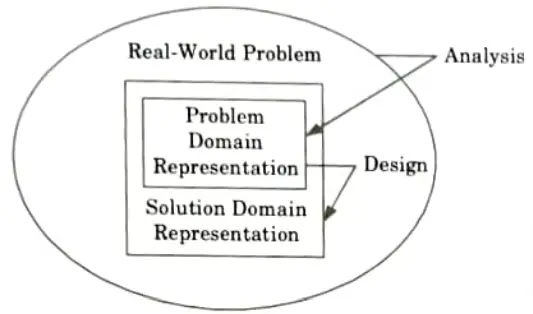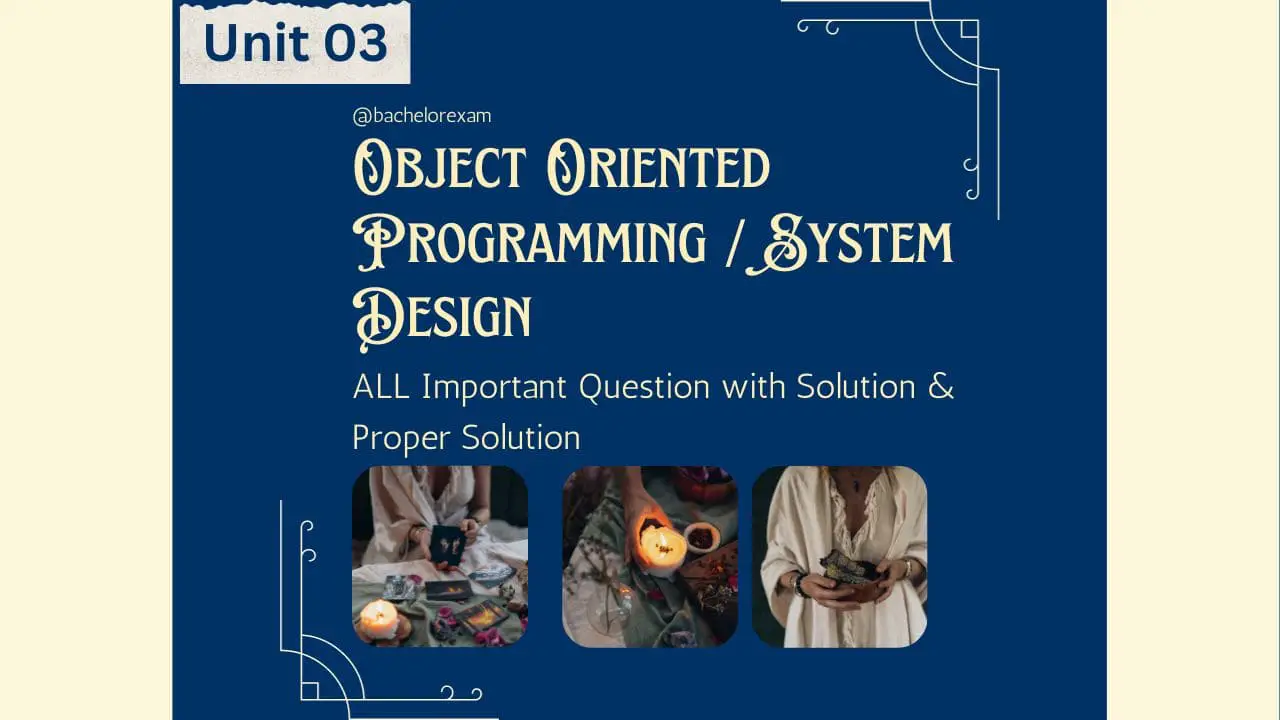Use Quantum Notes on Object-Oriented Programming/System Design to get ready for success in the Aktu Btech. For the best exam results, get important insights and commonly asked questions. Improve your academic progress right now! Unit-3 Object Oriented Analysis
Dudes 🤔.. You want more useful details regarding this subject. Please keep in mind this as well. Important Questions For Object Oriented Programming/System Design: *Aktu Quantum *B.tech-Syllabus *Circulars *B.tech AKTU RESULT * Btech 3rd Year * Aktu Solved Question Paper
Q1. Write short note on object oriented analysis and object oriented design.
Ans. Object oriented analysis :
- 1. Object-Oriented Analysis (OOA) is the procedure of identifying software engineering requirements and developing software specifications in terms of a software system’s object model, which comprises of interacting objects.
- 2. The primary tasks in object-oriented analysis (OOA) are:
- a. Identifying objects
- b. Organizing the objects by creating object model diagram.
- c. Defining the internals of the objects, or object attributes.
- d. Defining the behavior of the objects, i.e., object actions.
- e. Describing how the objects interact.
- 3. The common models used in O0A are use cases and object models.
Object-Oriented Design:
- 1. Object-oriented Design (OOD) involves implementation of the conceptual model produced during object-oriented analysis.
- 2. In OOD, concepts in the analysis model, which are technology independent, are mapped onto implementing classes, constraints are identified and interfaces are designed, resulting in a model for the solution domain, i.e., a detailed description of how the system is to be built on concrete technologies.
- 3. The implementation details include:
- a. Restructuring the class data (if necessary),
- b. Implementation of methods, i.e., internal data structures and algorithms,
- c. Implementation of control, and d Implementation of associations.
Q2. What are the three models in OMT ? How is the object oriented analysis and design attached with OMT? Explain with an example.
Ans. Following are the three models in OMT:
- 1. Object model:
- a. Object model encompasses the principles of abstraction, encapsulation, modularity, hierarchy, typing, concurrency and persistence.
- b. Object model emphasizes on the object and class.
- c. Main concepts related with object model are classes and their association with attributes.
- d. Predefined relationships in object model are aggregation and generalization (multiple inheritance).
- 2. Dynamic model :
- a. Dynamic model involves states, events and state diagram (transition diagram) on the model.
- b. Main concepts related with dynamic model are states, transition between states and events to trigger the transitions.
- c. Predefined relationships in object model are aggregation (concurrency) and generalization.
- 3. Functional model:
- a. Functional Model focuses on the how data is flowing, where data is stored and different processes.
- b. Main concepts involved in functional model are data, data flow, data store, process and actors.
- c. Functional model describes the whole processes and actions with the help of data flow diagram (DFD).
OOAD attachment with OMT:
- 1. Object Modeling Technique (OMT) combines the three views of modeling systems.
- 2. The object model represents the static, structural, “data” aspects of a system.
- 3. The dynamic model represents the temporal, behavioral, “control” aspects of a system.
- 4. The functional model represents the transformational, “function” aspects of a system.
- 5. A typical object oriented software procedure incorporates all three aspects: It uses data structures (object model), it sequences operations in time (dynamic model), and it transforms values (functional model). Each model contains references to entities in other models.
- 6. For example, operations are attached to objects in the object model but more fully expanded in the functional model.
Q3. Describe the relation of functional model, object model and dynamic models. What is relationship and difference between OOA (Object oriented analysis) and OOD (Object oriented design) ?
Ans.
- 1. The functional model shows what “has to be done” by a system. The leaf process are the operation on objects.
- 2. The object model shows the “doers” the objects. Each process is implemented by a method on some object.
- 3. The dynamic model shows the sequences in which the operations are performed. Each sequence is implemented as a sequence, loop or alteration of statements within some method.
- 4. The processes in the functional model correspond to operations in the object model.
- 5. Actors are explicit objects in the object models. Data flows to or from actors represent operations on or by the objects.
- 6. Because actors are self-motivated objects, the functional model is not sufficient to indicate when they act. The dynamic model for an actor object specifies when it acts.
Relationship between OOA and OOD:
- 1. When object orientation is used in analysis as well as design, the boundary between OOA and OOD is blurred. This is particularly true in methods that combine analysis and design.
- 2. One reason for this blurring is the similarity of basic constructs (i.e., objects and classes) that are used in OOA and OOD.



Difference between OOA and OOD:
- 1. The fundamental difference between OOA and OOD is that OOA models the problem domain, leading to an understanding and specification of the problem, while the OOD models the solution to the problem.
- 2. That is, analysis deals with the problem domain, while design deals with the solution domain.
Q4. What do you mean by the optimization of design ? Discuss the design optimization with suitable example using diagrams.
Ans. Optimization of design:
- 1. Design optimization is an engineering design methodology using a mathematical formulation of a design problem to support selection of the optimal design among many alternatives.
- 2. Design optimization involves the following stages:
- a. Variables: Describe the design alternatives.
- b. Objective: Elected functional combination of variables (to be maximized or minimized).
- c. Constraints: Combination of variables expressed as equalities or inequalities that must be satisfied for any acceptable design alternative.
- d. Feasibility: Values for set of variables that satisfies all constraints and minimizes/maximizes objective.
For example : Consider the design of a company’s employee skills database. Fig. shows a portion of the analysis class model. The operation companyfindskill() returns a set of persons in the company with a given skill. For example, an application might need all the employees who speak Japanese.



Q5. What do you mean by documentation? What are the various considerations in documentation designing? Explain.
Ans. Documentation :
- 1. Documentation is a software development process that records the procedure of making the software.
- 2. The design decisions need to be documented for any non-trivial software system for transmitting the design to others.
- 3. Though a secondary product, a good documentation is indispensable, particularly in the following areas:
- a. In designing software that is being developed by a number of developers.
- b. In iterative software development strategies.
- c. In developing subsequent versions of a software project.
- d. For evaluating a software.
- e. For finding conditions and areas of testing.
- f. For maintenance of the software.
Various Consideration of documentation designing:
- 1. It is a roadmap:
- a. It allows standardization, and it helps to identify the stages that can be improved.
- b. Process documentation also facilitates the training of new employees.
- 2. It is everyone’s task:
- a. The members of an area or project are responsible for documenting their processes.
- b. Every employee knows their own functioning, their strength, and their weakness, so they are the ones better indicates to document their processes.
- 3. Make them public:
- a. The documentation of the processes must be available to all team and company members.
- b. Restricting access to documentation creates the false illusion that it’s only relevant to a particular group.
- 4. Flexible documentation:
- a. Companies change, update, improve, so their processes are also subject to constant changes. To improve the effectiveness of the process, incorporate the necessary adjustments to the documentation of the process.
- b. Document the date of the last update.
- c. Save a backup copy of the files that document the process.
- d. Review the documents at least once a year.
Q6. Explain structured analysis and structured design (SASD) with example.
Ans. Structured analysis and structure design:
- 1. Structured Analysis and Structured Design (SAVSD) is diagrammatic notation which is design to help people understand the system.
- 2. The basic goal of SA/SD is to improve quality and reduce the risk of system failure.
- 3. It establishes concrete management specification and documentation.
- 4. It focuses on solidity, pliability and maintainability of system.
- 5. The approach of SA/SD is based on the Data Flow Diagram.
- 6. It is easy to understand SA/SD but it focuses on well defined system boundary whereas JSD approach is too complex and does not have any graphical representation.
- 7. SA/SD is combined known as SAD and it mainly focuses on following three points:
- a. System
- b. Process
- c. Technology
- 8. SA/SD involves two phases:
- a. Analysis Phase: It uses Data Flow Diagram, Data Dictionary. State Transition diagram and ER diagram.
- b. Design Phase: It uses Structure Chart and Pseudo Code.
- 9. For example:
- i. During structured design, data flow diagram processes are grouped into tasks and allocated to operating system processes and CPUs.
- ii. Data flow diagram processes are converted into programming language functions, and a structure chart is created showing the procedure call tree.



Important Question with solutions | AKTU Quantums | Syllabus | Short Questions
Object Oriented Programming/System Design Btech Quantum PDF, Syllabus, Important Questions
| Label | Link |
|---|---|
| Subject Syllabus | Syllabus |
| Short Questions | Short-question |
| Question paper – 2021-22 | 2021-22 |
Object Oriented Programming/System Design Quantum PDF | AKTU Quantum PDF:
| Quantum Series | Links |
| Quantum -2022-23 | 2022-23 |
AKTU Important Links | Btech Syllabus
| Link Name | Links |
|---|---|
| Btech AKTU Circulars | Links |
| Btech AKTU Syllabus | Links |
| Btech AKTU Student Dashboard | Student Dashboard |
| AKTU RESULT (One VIew) | Student Result |
